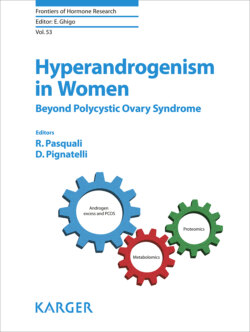Читать книгу Hyperandrogenism in Women - Группа авторов - Страница 18
Naturally Occurring in utero Androgen Excess and Female Hyperandrogenism: Origins of PCOS beyond Humans?
ОглавлениеNaturally occurring high levels of T confer athletic advantage in women [89] and accompany female behavioral dominance in some, but not all, nonhuman primates [90, 91]. About 15–25% of women in their reproductive years exhibit androgen excess, but most have PCOS [92]. Naturally occurring, hyperandrogenic (high T) female macaque monkeys emulate PCOS women in the co-occurrence of PCOS-like traits [93, 94]. In a multi-Primate Research Center study, adult female macaques with average BMI and in prime reproductive years were identified with high levels of T, 1SD above each population mean. Naturally occurring high T levels were observed in 3 separate laboratory populations of macaques. In the Wisconsin rhesus monkey population [94], PCOS-like traits of high T females exhibited generalized hyperandrogenism and increased steroidogenesis, including elevated circulating levels of unbound, “free” testosterone (unpublished results), hypersecretion of both LH and AMH, as well as uterine endometrial hyperplasia and infertility (Table 1). Intriguingly, a predominance of infertility and insulin resistance is found among high T monkeys with the most extreme elevations of T, 2SD above the monkey population mean (unpublished results), and equivalent to hyperandrogenic criteria required for peer-reviewed clinical studies of PCOS [95].
Table 2. Classification of PCOS-like phenotypes in PCOS-like adult female rhesus monkeys and in women with PCOS
High T, in and of itself, may not impair either fertility or metabolic function. Subtle changes in anatomical biomarkers of prior T exposure suggest fetal origins for naturally hyperandrogenic female rhesus monkeys [94], analogous to findings in behaviorally dominant female Malagasy lemurs [91], a more ancient branch of nonhuman primates. Interestingly, mild-to-moderate PCOS-like phenotypes were typically those identified among naturally hyperandrogenic female monkeys, emulating PCOS phenotype prevalence in studies of women recruited from local populations, and not from clinical referrals (Table 2). The contrast of predominantly mild-to-moderate phenotypes in naturally occurring PCOS-like monkeys and PCOS women recruited from local human populations to the predominantly severe and classic phenotypes of early-to-mid gestation T-exposed monkeys and clinically referred PCOS women suggests commonality in PCOS phenotype may include duration or degree of gestational T exposure, age, and BMI (younger age and normal BMI with more mild-to-moderate phenotype). Naturally occurring PCOS-like phenotypes beyond humans certainly support increasing speculation of survival and reproductive advantages from hyperandrogenic, energy-conserving, insulin resistant, delayed fecundity, female phenotypes [1, 96].
